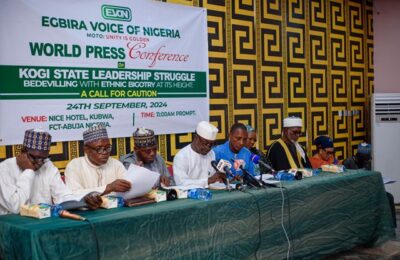In 1907, Oga and Egbe in Yagba West Local Government of Kogi State, became the first towns in Yagba land to welcome Christianity through Pategi. Two whitemen, E.P Lang and Tommie Titcombe made this possible. Some 12 years later, precisely in 1919, the White man’s religion made an inroad into Ilu-Oke, (Town on the Hill) a quiet agrarian settlement located on a mountainous range. These efforts were pioneered by the Sudan Interior Mission, SIM, which later metamorphosed into Evangelical Church Winning All, ECWA.
How time flies. It is now one hundred years ago and the people of Ilu-Oke, who have since 1926 relocated to a more friendly terrain called Takete-Idera, in present Mopa Muro Local Government Area have been in a jubilant mood. The people set aside Friday, 20th through Sunday, 22nd December for a grand centenary celebration of the birth of Christianity in their community.
Appropriately tagged “Let there be light…” the event witnessed service of songs, crusades, book launch and conferment of awards. Sons and daughters of the community travelled from far and near to join their kindred and parents at home for the occasion. They all came out in colourful Aso Ebi uniform customised for the the centenary.
The events were harmonized by a Guest Speaker, Rev. Adeotola aka Oyibo Egbe. His choice was deliberate. Adeotola, a light skinned ECWA clergy and native of Egbe had acted Tommie Titcombe in a 2007 home video that documented the birth of Christianity in Yagbaland. The fiery preacher focused on the theme and enjoined individuals and the community to embrace the light of God, as their forefathers did.
In 100 years, the church planted at that time has known 29 resident ministers, with many of them being Reverends, a title used for senior clergymen in the denomination. The current Minister in charge, is Rev. D.S Pelemo. The church has multiplied in other denominations. Takete-Ide today harbours some 13 Christian denominations. It is also instructive that Christianity has more or less effecticely shut the door against other religions notably traditional religions and Islam. Today, apart from pockets of animists, every native of Takete-Ide is a Christian. Not one is a Muslim.
Highlight of the celebrations is the public presentation and launching of 1,600 Kilometres by foot Takete-Ide: People, Culture and Christianity – a book on the advent of Christianity in the community. A quick flip through the 75-page book tells the story eloquently like an eye witness.
The tree of Christianity in Takete-Ide, Amuro has deep and wide roots in the early sacrifices and pioneering evangelical mission of some local missionaries who shouldered the burden of introducing the people to the ‘new’ God. Prior to this new religion, Takete-Ide forebears were pagans and traditional religion adherents.
The book is a compendium of the early deprivation, self denial and uncommon courage shown by the early Christ warriors who set out to unfurl the banner of Christianity and win souls for God despite all odds.
It is divided into five short chapters, with each providing deep insights into the roles of key people and instittutions, as well as their travails in putting Christianity on a sound footing. Although its primary focus is the history of Christianity in Takete-Ide, it is a one-stop material on the people, culture and history of Takete-Ide.
Chapter one attempts a historical introspection of the source or origin of the Yagba People to which Takete-Ide Amuro belongs. The author relies on oral tradition to explain the movement of an Ile-Ife prince who went in search of territorial expansion. The account reveals how his late reporting of his progress in accomplishing his objectives to his elders back home earned him a reprimand to which he answers, “Iya agba lojemi” (My mistake was due to lack of elders’ counsel). The other account traces the origin of the people to a princess of Oyo Ile known as Iya agba who led other immigrants to settle in Yagba land back then.
In both accounts, there is a unanimity of evidence that the ancestral lineage of the Yagba people is traceable to the Yoruba people of the South West. Researchers and scholars have also corroborated this evidence in their studies which remain documented and serve as useful reference and resource materials for all lovers of history.
The chapter (one) also chronicles the struggles, race for survival, and the frequent migration of the people of Takete-Ide Amuro from their original place at Amuro Odo as a result of constant raids by the Nupe warriors, their northern neighbours. It traces the migration of the people through places like Igbo-Ide, Ilu-Oke, Okeata and Odede.The search for safety and peace ultimately led them to their present location through the divinational powers of a hunter- Pa Thomas Ode, the first settler in the new location sometime around 1926.
Beyond the migration narrative, the chapter focuses intensely on aspects of the tradition and culture of the community. It demonstrates religious tolerance in its coverage of Egungun (including Agado, Oliwo, Alase and Ojingindo), Imole, Ogbele and reference to moni moni, Mori momori and other childhood pranks truly sheds light on Takete-Ide in a state of nature.
Chapter two traces the spread of Christianity in Nigeria and the role played by the Portuguese. The chapter recalls how the parents of the infant Jesus escaped to Egypt in Africa on exile. It also explains how early Christian activities first took root in Africa outside its place of birth, thus effectively making the continent the cradle of the faith. The book haps on the pioneering efforts of the Anglicans, Catholics, Methodists, Baptists, SIM, among others after the abolition of the slave trade. Bishop Samuel Ajayi Crowther a rescued slave and Rev. Townsend are principal actors in the chapter.
Chapter three goes into the details of the evangelical exploits of the trio of Walter Gowans, a Canadian and only son of Mrs Gowans, the bearer of the burden of the Sudan, Rowland V Bingham, also a Canadian and Thomas Kent, an American, in taking Christianity to the people of the interior through the Sudan Interior Mission, SIM. The unforgettable contributions of Thomas Titcombe who set up schools and stopped the killing of twins in Yagbaland in addition to evangelism, receive good mention. Their efforts (white missionaries and that of Rev. K.P. Titus, the first Yagba priest are contained here.
Chapter four focuses on the Advent of the new religion in Takete-Ide. The chapter tells the story of the significant roles played by Pa Joash Abereoran, Pa Daniel and Pa Peter Olowadara, in bringing Christinaity to Takete-Ide. It was through these three men that Takete-Ide people first had contact with the maker of the universe in the Christian sense.
At the beginning, the first converts were worshiping inside caves and other secret locations. Readers will be impressed by the roles played by the District Officer D.O (a white missionsry) and the Oba of Yagba land in getting approval for the new converts to have a suitable plot of land for the church. Early church building had other stars like Pa Davidi Olukomogbon, Luke Olorunleke, Pa Motojehi, Pa Olowodara, among others who did so much to plant the church and faith in Takete Ide.
In fact, the title of the book- 1,600 Kilometres by foot is taken from the efforts of these men. The reader should explore how Pa. Olowodara led seven other devotees to and from Lagos- a journey of about 1,600 by foot to acquire an iron bar (agogo) for the church. It is instructive that the ago is still in use today some 80 years after it arrived in the young church on 24th May, 1939!
The chapter contains details about the growth of the Church such as first converts, first baptism, first Holy Communion, first choirsters, missionary visitors and pastors nominal roll.
Chapter five is the last. It is a review on the impact of Christianity in the community. It shows how the missionaries introduced western education, better healthcare and civilization. Readers will encounter pioneer students of Takete-Ide and how education had changed the face of the community.
The book is written in simple English. Readers may encounter few typographical errors such as board of ‘Elder’ instead of elders, misplaced headings in chapters two and three, etc. But, even at that, the book is a bold academic effort in the right direction. it’s high flowing narratives and good command of the English Language are commendable..
For the people, it is one hundred years of enjoying the light. And still counting.
Credits: Richard Elesho | TheNews




